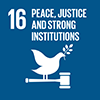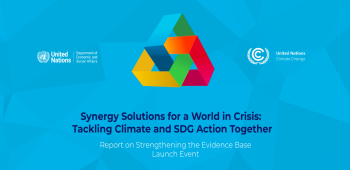
Violence against children
Overview
Targets and Indicators

16.1
Significantly reduce all forms of violence and related death rates everywhere
16.1.1
16.1.2
16.1.3
Proportion of population subjected to (a) physical violence, (b) psychological violence and/or (c) sexual violence in the previous 12 months
16.1.4
Proportion of population that feel safe walking alone around the area they live after dark

16.2
End abuse, exploitation, trafficking and all forms of violence against and torture of children
16.2.1
Proportion of children aged 1–17 years who experienced any physical punishment and/or psychological aggression by caregivers in the past month
16.2.2
16.2.3
Proportion of young women and men aged 18–29 years who experienced sexual violence by age 18

16.3
Promote the rule of law at the national and international levels and ensure equal access to justice for all
16.3.1
Proportion of victims of (a) physical, (b) psychological and/or (c) sexual violence in the previous 12 months who reported their victimization to competent authorities or other officially recognized conflict resolution mechanisms
16.3.2
16.3.3
Proportion of the population who have experienced a dispute in the past two years and who accessed a formal or informal dispute resolution mechanism, by type of mechanism

16.4
By 2030, significantly reduce illicit financial and arms flows, strengthen the recovery and return of stolen assets and combat all forms of organized crime
16.4.1
16.4.2

16.5
Substantially reduce corruption and bribery in all their forms
16.5.1
16.5.2

16.6
Develop effective, accountable and transparent institutions at all levels
16.6.1
16.6.2
Proportion of population satisfied with their last experience of public services

16.7
Ensure responsive, inclusive, participatory and representative decision-making at all levels
16.7.1
Proportions of positions in national and local institutions, including (a) the legislatures; (b) the public service; and (c) the judiciary, compared to national distributions, by sex, age, persons with disabilities and population groups
16.7.2

16.8
Broaden and strengthen the participation of developing countries in the institutions of global governance
16.8.1
Proportion of members and voting rights of developing countries in international organizations

16.9
By 2030, provide legal identity for all, including birth registration
16.9.1

16.10
Ensure public access to information and protect fundamental freedoms, in accordance with national legislation and international agreements
16.10.1
16.10.2

16.a
Strengthen relevant national institutions, including through international cooperation, for building capacity at all levels, in particular in developing countries, to prevent violence and combat terrorism and crime
16.a.1

16.b
Promote and enforce non-discriminatory laws and policies for sustainable development
16.b.1
Progress and Info
Around the world, we need peace in every sense. Yet the road to global peace and security has become even more complex. Global forced displacement is at an all-time high, exceeding 110 million people forced to flee from persecution, conflict, violence and human rights violations as of May 2023. Between 2022 and 2023, civilian casualties experienced the highest spike since the adoption of the 2030 Agenda. Persistent threats to human security across the globe underscore the breakdown of peaceful and inclusive societies, crucial for sustainable development and the need to restore trust and strengthen and renew global peace and security frameworks to heed the desperate pleas for peace from countless voices worldwide.
Target 16.1: o The global homicide rate gradually decreased, falling from 5.9 victims per 100,000 population in 2015 to 5.5 in 2020. However, this trend was disrupted in 2021, with a sharp rise to 5.8 victims per 100,000 population, only slightly decreasing to 5.6 in 2022. High levels of violence linked to organized crime and gang activities in Latin America and the Caribbean, along with Africa's heightened vulnerability to homicide, continue to contribute to these regions having the highest homicide rates and numbers globally.
o The number of civilian deaths in armed conflict skyrocketed in 2023. Between 2022 and 2023, civilian casualties increased by 72%, the highest increase since 2015. In 2023, seven out of ten recorded deaths occurred in the Occupied Palestinian Territory and Israel. Moreover, for the second consecutive year, the number of civilians killed in conflict has risen dramatically; reversing the downward trend between 2016 and 2019. By 2023, the number of civilian casualties had risen to over 33,400, almost matching the peak of 2015. By 2023, four out of every ten civilians killed in conflicts were women, and three in ten civilians killed were children, doubling and tripling, respectively, the previous year’s proportion.
o Data on experience of violence, remain limited outside of Europe and Northern America and Latin America and the Caribbean. Available data show women and men are not impacted by the same type of violence. The median prevalence of sexual violence in countries with data is 3.0% for women compared to just 0.8% for men. However, the median prevalence of physical violence is 3.0% for men compared to 2.1% for women.
Target 16.2: Violent discipline is the most common and widespread form of violence against children. In 82 (mostly low- and middle-income) countries with available data from 2015 to 2023, nearly 8 in 10 children from 1 to 14 years of age were subjected to some form of psychological aggression and/or physical punishment at home in the past month.
Target 16.3: o Available data for 53 countries for the period 2010-2022 shows that the proportion of victims of physical assault and robbery in the previous 12 months that reported their victimization to competent authorities, shows a median proportion in countries with data of 36% and 45%, respectively. This is notably higher than the proportion of victims of sexual assault that reported their victimization, for which the median in countries with available data was of 17%.
o Globally, the estimated number of persons in detention was 11.4 million in 2022, representing a prison-population rate of 142 prisoners per 100,000 population. In 2022, nearly a third (3.5 million) of the global prison population was being held in pre-trial detention and their share remained stable between 2015 and 2022 (around 30%).
Target 16.5: Based on data from 138 countries between 2015 and 2022, 19% of people who had contact with public officials in the last 12 months reported being asked to pay or paid a bribe to a public official. Regional differences range from an average of 32% in low-income countries to 9% in high-income countries.
Target 16.6: Budget reliability improved in 2021 and 2022, reaching an average of 13.5% compared with 15.3 % in 2020 but remained weaker than pre-pandemic levels with 10.6% on average. In part, this is due to the incidence of new international challenges including global political stresses, inflation and resource price volatility.
Target 16.7: The overall representation of people under the age of 45 or less in parliaments is increasing globally but with contrasting trends: a rise in developing countries and a decline in developed ones. Moreover, growth in women’s share of parliamentary leadership posts continues to be slow-moving, albeit steady. As of 1 January 2024, women presided over 23.8% of parliaments as Speakers (an increase of 2.9 percentage points since 2021) and held 27.2% of committee chair posts.
Target 16.9: While a few regions like Northern America and Europe and Australia and New Zealand have achieved universal birth registration, only half of African children under five have had their births registered.
Target 16.10: o The number of killings of human rights defenders, journalists, and trade unionists recorded by national human rights institutions and the United Nations decreased in 2023; to 320 cases in 40 countries, compared to 448 cases in 36 countries in 2022. In conflict zones, however, there was a sharp increase in journalists and media workers killed – 40 lives lost – reversing the downward trend since 2017. Additionally, enforced disappearances have been nearly doubling for the second consecutive year, with at least 54 cases reported across 14 countries in 2023. Strong protection frameworks are therefore needed to stem this trend, particularly in countries where violent conflict or social unrest erupts or escalates.
o In 2024, 140 countries had laws that specifically guaranteed the rights of citizens to access public information, up from 105 in 2015 and 14 in 1990.
Target 16.a: Between 2015 and 2023, the number of countries with independent national human rights institutions (NHRIs) meeting international standards increased by 23%. More than 40% of countries now have independent NHRIs.








